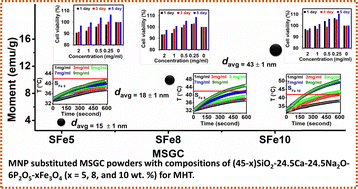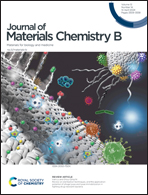Enhancement in the induction heating efficacy of sol–gel derived SiO2–CaO–Na2O–P2O5 bioglass-ceramics by incorporating magnetite nanoparticles
Abstract
Magnetite (Fe3O4) nanoparticle (MNP)-substituted glass-ceramic (MSGC) powders with compositions of (45 − x)SiO2–24.5CaO–24.5Na2O–6P2O5–xFe3O4 (x = 5, 8, and 10 wt%) have been prepared by a sol–gel route by introducing Fe3O4 nanoparticles during the synthesis. The X-ray diffraction patterns of the as-prepared MSGC nanopowders revealed the presence of combeite (Na2Ca2Si3O9), magnetite, and sodium nitrate (NaNO3) crystalline phases. Heat-treatment up to 700 °C for 1 h resulted in the complete dissolution of NaNO3 along with partial conversion of magnetite into hematite (α-Fe2O3). Optimal heat-treatment of the MSGC powders at 550 °C for 1 h yielded the highest relative percentage of magnetite (without hematite) with some residual NaNO3. The saturation magnetization and heat generation capacity of the MSGC fluids increased with an increase in the MNP content. The in vitro bioactivity of the MSGC pellets was evaluated by monitoring the pH and the formation of a hydroxyapatite surface layer upon immersion in modified simulated body fluid. Proliferation of MG-63 osteoblast cells indicated that all of the MSGC compositions were non-toxic and MSGC with 10 wt% MNPs exhibited extraordinarily high cell viability. The MSGC with 10 wt% MNPs demonstrated optimal characteristics in terms of cell viability, magnetic properties, and induction heating capacity, which surpass those of the commercial magnetic fluid FluidMag-CT employed in hyperthermia treatment.



 Please wait while we load your content...
Please wait while we load your content...